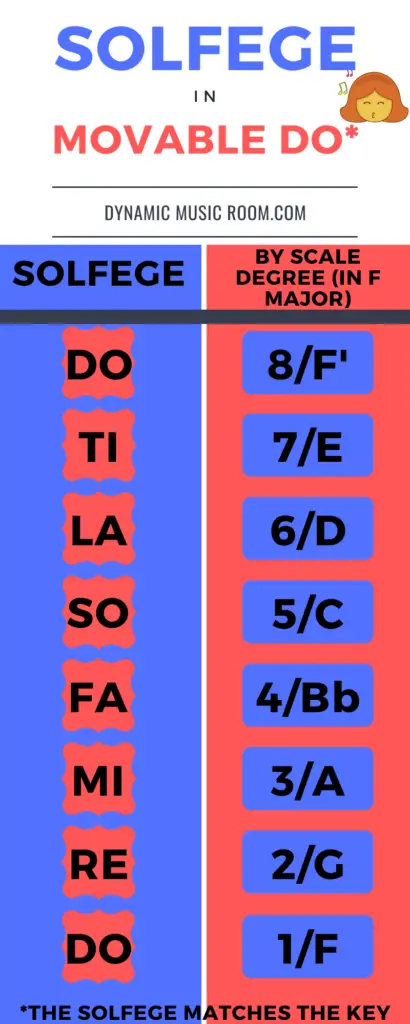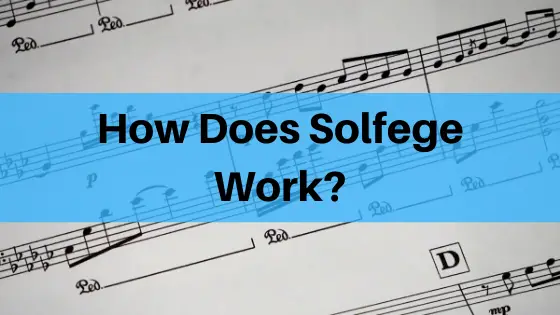I never used solfege in my elementary or high school music classes as a kid, so when I got to college and had to learn how to use it, I was a little lost. I always found myself wondering: how does solfege work?
Solfege replaces pitches in a key with syllables to help musicians sing and hear the melody better. This develops a better sense of pitch and increases sight-singing, sight-reading, and intonation skills.
Read on for more information on if solfege works, why it works, and 3 quick solfege activities.
Table of Contents
Does Solfege Work?
Before delving into the world of solfege, it’s important to look at if solfege even works. According to research, it does.
Implementing solfege increase sight-singing achievement in second graders (James L. Reifinger Jr. in Journal of Research in Music Education).
Solfege also works with high schoolers as well. Michele L. Henry in the Journal of Research in Music Education found that singers sang melodies better when targeting pitch skills.
These are just two of many research studies proving solfege’s importance as a music tool. The overwhelming trend points towards solfege’s positive impact on learning.
Why Does Solfege Work?
There are many theories and reasons for why solfege works the way it does. Here are a few of the main ones used by experts to argue for the inclusion of solfege.
Pattern Recognition – One way solfege may help is through pattern recognition. Using solfege, musicians can isolate and practice melodic patterns. Check out these do, mi, sol songs.
This repetition helps imprint how melodies sound in the brain of students.
Develop Understanding Of Pitch Relationships – Whether you use movable do or fixed do, solfege syllables help build an understanding of pitch relationships.
For example, do and re will always be a whole step or major second apart. Singing these patterns reinforces the relationships in your ear.
Linguistic Intelligence – Another theory on why solfege works is how it accesses the linguistic intelligence. While music naturally activates much of the brain, by adding specific syllables, you’re now activating even more of the brain.
With the language centers further activated, you can develop the synapses in your brain to access and remember the knowledge of pitches and melodies better.
Music Theory Understanding – As I mentioned before, solfege helps you learn about pitch relationships. This is then easily transferred into a better understanding of important music theory elements.
For example, you can explain with words how a Major I chord is built on the first, third, and fifth scale degree in a major key. You can even have the kids sing or play this.
But after using solfege, you give the students an immediate and real example of how this works in songs with pitches, do, re, and mi.
Kinesthetic Understanding (Optional) – For those using Curwen hand signs, solfege also accesses Kinesthetic intelligences. This is like we said before with linguistic intelligence, but now even deeper and faster.
It’s also a great way to differentiate your instruction for your students.
Solfege – Movable Do Vs. Fixed Do
Most people know what the solfege pitches belong to (there are literally thousands of examples online at your fingertips). Most of them belong to movable do, but the Dalcroze method and others also advocates for fixed do.
Movable do is when the solfege pitches move to match the key you’re singing or playing in. For example, “DO” will always match the tonic or first scale degree.
Examples:
- In C major, C = DO.
- In F major, F = DO.
- In G major, G = DO.
For fixed do, the solfege syllables always belong to a specific pitch regardless of key. This never changes.
- C = DO
- D = RE
- E = MI
- F = FA
- G = SO
- A = LA
- B = TI
(I know there are a ton out there, but here’s a quick movable do reference chart in the key of F for you.)

3 Solfege Activities
In this section, I’ll give you 3 of my favorite solfege activities. These can be used in your classrooms right away, regardless of level, ensemble, or instrument.
Note: These games weren’t created by me, but they are fun!
Shuffle Melody
For this game, students will need to already be familiar with solfege pitches. Depending on your level and method of choice, these pitches may be as simple as sol and mi or you may want to use all 12.
Use cards or letters representing the solfege notes and arrange them on a board for students to see and read. Start with an easy and logical melody.
Then, you shuffle or students shuffle the cards to create a new random pattern. Challenge the students to read this.
Repeat as needed, adding more cards to make the pattern longer and more challenging.
Mystery Song
Arrange a well-known song using solfege letters or actual pitches on a staff for students to read. Challenge them to see if they can figure out the mystery song.
I usually go in this order to help them if they can’t figure it out.
- Guess just by looking at the notes.
- Sing the pitches together and guess.
- Teacher sings the pitches matching the song for the students.
- Teacher adds a few of the beginning words.
Pro-tip: There will always be the same few kids who get the song right away (and you probably know who they are). I don’t let these same students constantly blurt out the answers.
When I do this, I often go through the first 3 steps every time. I take a gauge on the students by asking for a show of hands to see how many figured it out.
Then, I encourage students to whisper the answer to each other so all feel successful. Then, the whole class will say it to me.
Solfege Piano
I adore solfege piano. In this activity, students are split into small groups.
Each of the small groups is assigned a specific solfege note. Then they sing their solfege note when you point to them.
This can be combined with the above two games to make them fresh or more challenging.
What I love most about this game is the focus it requires from students. They need to know their note, when to sing, and when the others are singing.
It also gives you a chance to strategically place strong and weak singers together to develop the weaker singers’ independent musicianship without exposing them uncomfortably.
Who Uses Solfege?
Traditionally, solfege is considered a standard tool of Kodaly, Gordon, Dalcroze, and Conversational Solfege in the elementary classroom.
In secondary music, solfege is used mainly in the choral classroom. This is the same at the collegiate level.
However, all methods (like Orff) in elementary music support solfege even if they aren’t “known” for using it. There are also instrumental band and orchestra programs that use solfege with great success even if it isn’t as common.
Conclusion
I hope you found this information on solfege helpful. Many teachers are scared to implement this or don’t see its effectiveness.
Hopefully, now you can see why many musicians use solfege.
Do you use solfege in your music classroom? Let us know in the comments below.

